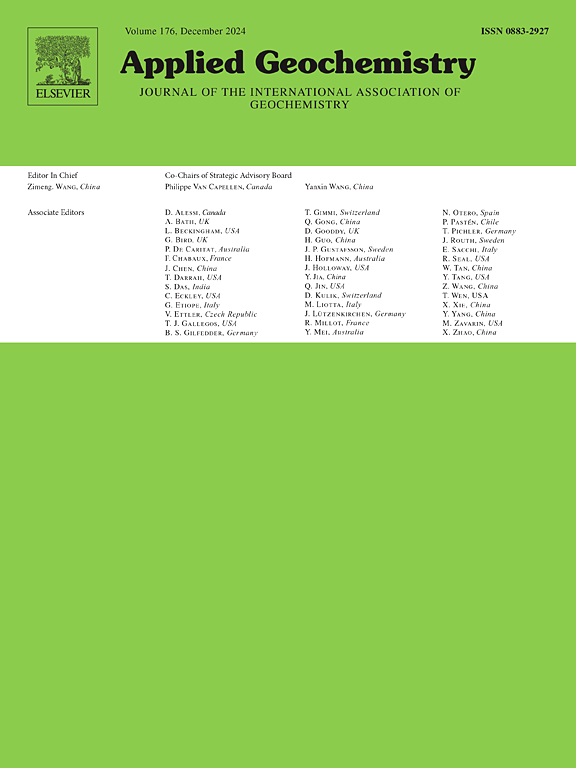Millimeter-scale leaf litter placement modulates carbon dioxide and methane emissions in wetlands
IF 3.4
3区 地球科学
Q1 GEOCHEMISTRY & GEOPHYSICS
引用次数: 0
Abstract
Flooded soils play a crucial role in global carbon cycling, acting as significant reservoirs of soil organic carbon and sources of carbon emissions. Leaf litter, especially from local vegetation, is a key contributor to soil organic carbon formation in these ecosystems, with its decomposition driving the production of carbon dioxide (CO2) and methane (CH4). Although numerous studies have examined the factors influencing leaf litter decomposition and associated greenhouse gas emissions, the impact of millimeter-scale variations in leaf litter placement within the soil-water interfaces (SWI) has received little attention. This study hypothesizes that even small changes in burial depth could significantly affect the emission patterns of CO2 and CH4. To test this hypothesis, a microcosm experiment was conducted to monitor gas fluxes and physicochemical profiles in treatments with leaf litter placed uncovered at the SWI (LU) or covered by a thin (10 mm) soil layer (LC). The results demonstrated substantial shifts in emissions: cumulative CH4 emissions were more than doubled in the LC group (115.3 μgC) compared to the LU group (42.5 μgC), while cumulative CO2 emissions were reduced by 25 % in the LC group (77 mgC) versus the LU group (103 mgC). Consequently, the overall global warming potential over a 20-year horizon (GWP20) was 13.2 % lower for the LC treatment (280.7 mgCO2e) compared to the LU treatment (323.3 mgCO2e). These findings advance our understanding of wetland carbon dynamics by revealing that a millimeter-scale change in leaf litter placement significantly alters the spatiotemporal patterns and partitioning of CO2 and CH4 emissions, highlighting the critical role of micro-scale heterogeneity in regulating greenhouse gas fluxes. Moreover, our results demonstrate a decoupling of CO2 and CH4 responses to this small-scale environmental variation, ultimately leading to a reduction in overall global warming potential despite increased methane release.
毫米尺度的凋落叶调节湿地的二氧化碳和甲烷排放
淹水土壤在全球碳循环中发挥着至关重要的作用,是土壤有机碳的重要储存库和碳排放源。凋落叶,特别是当地植被的凋落叶,是这些生态系统中土壤有机碳形成的关键贡献者,其分解驱动二氧化碳(CO2)和甲烷(CH4)的产生。虽然已有大量研究考察了凋落叶分解和相关温室气体排放的影响因素,但凋落叶在土壤-水界面(SWI)内的毫米尺度变化的影响却很少受到关注。本研究假设即使埋深的微小变化也会显著影响CO2和CH4的排放模式。为了验证这一假设,进行了一项微观实验,以监测在SWI (LU)未覆盖或覆盖薄(10 mm)土层(LC)的凋落叶处理的气体通量和物理化学特征。结果显示了排放量的实质性变化:LC组的累积CH4排放量(115.3 μgC)比LU组(42.5 μgC)增加了一倍多,而LC组的累积CO2排放量(77 mgC)比LU组(103 mgC)减少了25%。因此,LC处理的20年全球变暖潜势(GWP20)比LU处理的323.3 mgCO2e低13.2% (280.7 mgCO2e)。这些发现揭示了凋落叶在毫米尺度上的变化显著改变了CO2和CH4排放的时空格局和分配,突出了微尺度异质性在调节温室气体通量中的关键作用,从而促进了我们对湿地碳动态的理解。此外,我们的研究结果表明,CO2和CH4对这种小尺度环境变化的响应解耦,最终导致尽管甲烷释放增加,但总体全球变暖潜势降低。
本文章由计算机程序翻译,如有差异,请以英文原文为准。
求助全文
约1分钟内获得全文
求助全文
来源期刊

Applied Geochemistry
地学-地球化学与地球物理
CiteScore
6.10
自引率
8.80%
发文量
272
审稿时长
65 days
期刊介绍:
Applied Geochemistry is an international journal devoted to publication of original research papers, rapid research communications and selected review papers in geochemistry and urban geochemistry which have some practical application to an aspect of human endeavour, such as the preservation of the environment, health, waste disposal and the search for resources. Papers on applications of inorganic, organic and isotope geochemistry and geochemical processes are therefore welcome provided they meet the main criterion. Spatial and temporal monitoring case studies are only of interest to our international readership if they present new ideas of broad application.
Topics covered include: (1) Environmental geochemistry (including natural and anthropogenic aspects, and protection and remediation strategies); (2) Hydrogeochemistry (surface and groundwater); (3) Medical (urban) geochemistry; (4) The search for energy resources (in particular unconventional oil and gas or emerging metal resources); (5) Energy exploitation (in particular geothermal energy and CCS); (6) Upgrading of energy and mineral resources where there is a direct geochemical application; and (7) Waste disposal, including nuclear waste disposal.
 求助内容:
求助内容: 应助结果提醒方式:
应助结果提醒方式:


